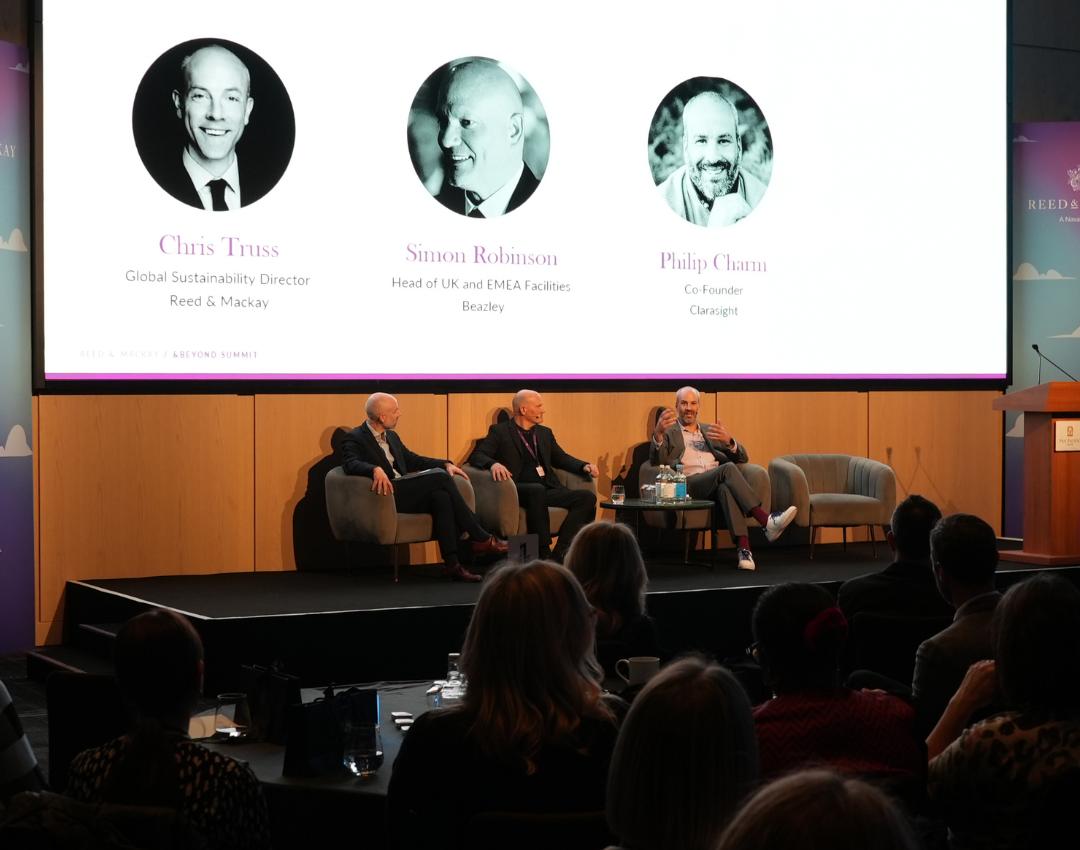Sustainability in corporate travel has moved beyond being a ‘nice to have’; it’s a necessity. Across industries, organisations are taking bold steps to reduce their carbon footprints. However, achieving real impact requires more than just setting targets. The real challenge lies in changing behaviours, embedding sustainability into company culture and balancing environmental responsibility with financial goals.
At Reed & Mackay’s recent flagship conference, the &Beyond Summit, Reed & Mackay Global Director of Sustainability Chris Truss spoke with Beazley Head of UK and EMEA Facilities Simon Robinson and Clarasight Co-Founder Philip Charm – who recently announced a partnership with Reed & Mackay – to explore the role of carbon budgeting in shaping the future of sustainable corporate travel.
Understanding the ‘why’ behind sustainable travel
Embedding sustainable business practices and encouraging behavioural change among employees is essential for long-term success. As Charm explains, a common issue in corporate settings is that organisations are focusing on the ‘what’, rather than the ‘why.’ As a result, businesses often rush to implement carbon reduction measures without fully understanding the underlying reasons for change.
To be effective, sustainable travel policies need full support across a business. Sustainability must become an integral part of the company, rather than an imposed requirement. Making sustainable choices easy and intuitive is an important first step.
Financial incentives remain one of the most effective ways to encourage sustainable behaviour. When employees are rewarded for choosing lower-carbon travel options, they’re more likely to make responsible decisions. However, incentives alone are not enough. Sustainability must become part of the company’s culture to deliver lasting change.
It must also be treated as a core business priority. When reducing emissions is recognised as a fundamental company value, employees naturally begin to reflect that in the way they travel. Leadership plays a vital role in driving this change. Senior executives must lead by example, demonstrating that sustainable travel policies apply equally to everyone across the organisation. This sends a clear message that sustainability is a genuine commitment.

The challenge of changing traveller behaviour
Encouraging employees to choose lower-emission travel options remains a significant challenge for organisations. While some companies have successfully introduced carbon budgets, others face industry-specific barriers. In certain sectors, when client demands or performance expectations are high, business-class travel is often essential.
Regional regulations add more complexity. In the United States, for example, sustainability reporting is often handled at a federal level rather than national level. This adds another layer of complexity for global businesses to implement consistent, company wide sustainability policies.
A carbon budgeting journey
Beazley, a FTSE 100 global specialist insurer, shows what can be achieved with clear goals and focused action. In 2022, Beazley set the bold target to reduce its carbon footprint from travel by 50% per employee (based on 2019 figures, which were the last full year of travel before the pandemic) to support a vision to become the highest-performing sustainable specialist insurer. It achieved this target in just one year through the introduction of carbon budgeting.
“The journey began in 2019 when we identified our baseline and then in 2022 implemented carbon budgeting,” Robinson says. “Each department was given a carbon allowance based on the size of their team and expected travel needs.
“Before the pandemic, we started to see employees voluntarily downgrading their travel,” Robinson adds. “This initially was to help departments with their P&L and meant that people could conduct more business travel for the same cost. However, the momentum continued to increase with the introduction of carbon budgets and an increase in employee engagement towards our vision.”
Despite success, challenges remain. Travel also carries an emotional weight. Employees may find it hard to turn down free upgrades, especially when these are often offered and processed before they arrive at the airport and have no opportunity to turn down the upgrade, even when sustainability is a priority. So, in some cases, sustainability goals can clash with business priorities. Furthermore, if an airline offers a complimentary upgrade without the travellers knowledge or request, who is accountable for the extra carbon emissions?

Looking ahead: carbon budgets vs financial budgets
The choice between using carbon budgets or financial budgets to support sustainability is ultimately shaped by company culture. The most effective approach depends on an organisation’s specific goals, values and industry.
For some, sustainability and cost savings go hand in hand. Lower-carbon travel options can often be more cost-effective. For others, achieving sustainability targets may require upfront investment but can lead to long-term advantages, such as a stronger corporate reputation and improved regulatory compliance.
It’s clear sustainability in corporate travel has moved beyond just setting targets and is now about embedding effective, lasting change. As companies refine their strategies, those that successfully build carbon budgeting into their culture will be better placed to achieve a truly sustainable future.
Mail [email protected] to discuss all your corporate travel and event management needs.




